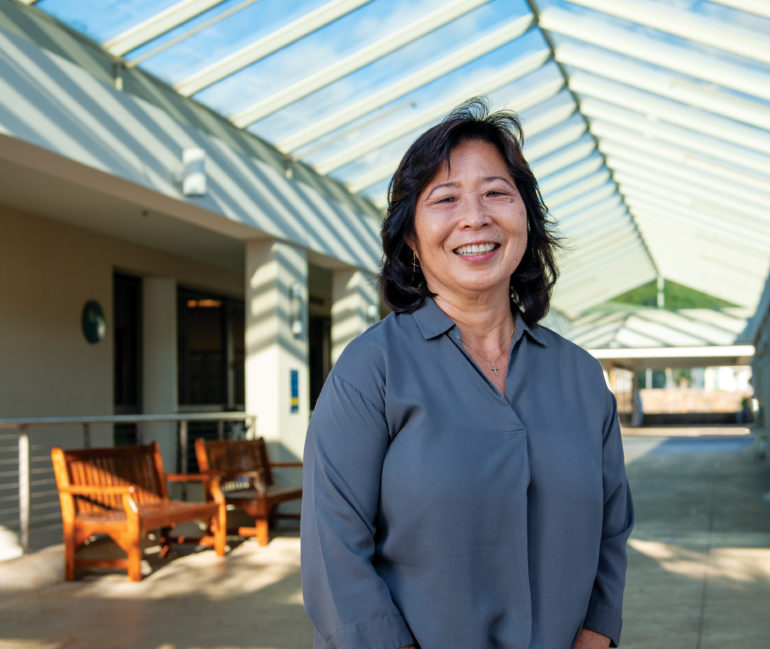Charlotte Kamikawa manages a crew of over 130 grounds-keepers, custodians and maintenance workers who care for the School’s 76-acre campus. The team was critical to getting students back on campus, working in tandem with the School’s Pandemic Response Team to implement countless health and safety measures. Kamikawa began her career at Punahou in 2002, after being hired to manage the construction of Case Middle School. Since then, she’s been an instrumental, behind-the-scenes leader, adjusting not only to the twists and turns of the pandemic, but helping manage the colossal construction projects that completely transformed the Junior School.
How does it feel seeing the buildings and spaces you helped manage during construction?
Because Case was my first project here, and there were multiple challenges, it has special meaning. During construction, there was a concrete workers’ strike, and we had 40 days of rain that really put our schedule behind. Twigg-Smith Pavilion also originally was going to be a Learning Commons, but it became a multi-use gathering and performance space. We also made the decision with Case to go for LEED Gold (green building certification), after the design phase, so there were a lot of moving parts. Omidyar was fun because it was for our youngest learners, so we did different things to cater to that age group. Then of course Kosasa was a huge, daunting project, which was built in two phases, and required students to be moved to different areas during construction. Despite the challenges, it’s been exciting to see our campus change, and I do feel connected to each project.
How did you get involved in construction management?
I have a finance degree, and I started as a cost engineer working for a General Contracting Company, keeping track of costs for large projects. While I was doing that, I was trained to become a project engineer. I was assigned to different jobs with senior project engineers, until they said, “Okay, you’re good. You are ready to go run your own project.”
What’s it like to be a woman in this field?
Well, when I first started, about 30 years ago, it was still a man’s world. It’s changed since then. I’ve talked to other people and they say, “There are a lot of women engineers out in the field now.” But back then, besides me, there was only one other women, a project secretary at my first job site – and it was a pretty big job site. As a woman, you really had to constantly prove that you could do the job, which was very challenging.
What has it been like for Punahou’s Physical Plant team during the pandemic?
Last spring, there was a big question mark about everything. Luckily, we had Ginia Loo ’92, who co-chairs the School’s Pandemic Response Team, to guide us through. It was a lot of work trying to procure materials; install plexiglass, sinks and hand-washing stations; assess spaces and purchase PPE. Even though the campus was closed for a good part of the year, we still had to plan for everyone to return. We’re very fortunate that Punahou was willing to spend the money, so that we could open the School. But yeah, it was a lot of work for everybody in Physical Plant. And our custodians, who have to go into classrooms to clean, sanitize and disinfect, had a lot of questions and concerns. Ginia again was instrumental in talking to everyone to calm everyone and explain what was needed. She assured us that the School would take every precaution for everyone’s health, not just students and teachers, but workers as well.
What do you like best about your job and working at Punahou?
This is a great educational institution, but what makes it most enjoyable is working with the people in our department. They are very supportive of me as their director, and more importantly, dedicated to the School. It’s really nice when the Punahou community shows appreciation for the work of our department, like when we receive thank you mail or goodies that we pass along to our workers. We did receive notes of appreciation when our employees returned to campus. People were pleasantly surprised by everything that was done to make their work area and the campus safe. They were like, “Oh look, I have a barrier.” Our employees really stepped up to get the School ready so we could bring our students back during COVID, and they’re continuing to do whatever it takes to keep our campus safe.

